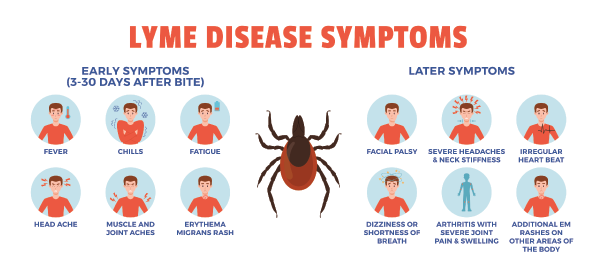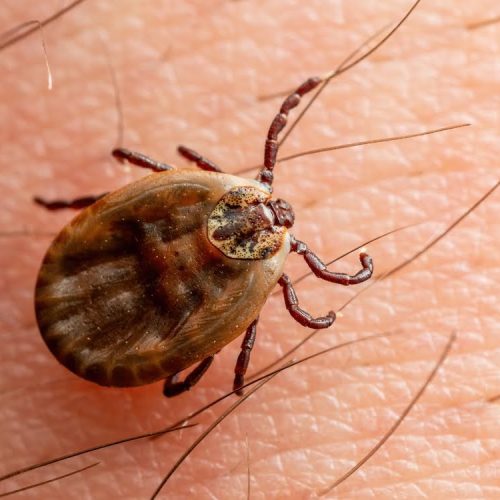Your guide to staying safe during Missouri’s tick-filled season
As spring unveils its warmth across Missouri, ticks are emerging in full force. These tiny pests bring risks not only to your family’s health but also to your beloved pets. At Steve’s Pest Control, we’re here to equip you with the knowledge and tools you need to stay protected. This guide will help you understand the tick species in Missouri, the diseases they carry, and how to safeguard your property and loved ones.
Missouri’s Tick Species: Know Your Enemy
Ticks may be small, but their impact can be huge. Missouri is home to several tick species, each with unique traits and associated health risks.
1. American Dog Tick (Dermacentor variabilis)
- Appearance: Brown with white markings on their backs, about 5mm when unfed.
- Habitat: Common across Missouri; active from early spring.
- Health Risks: Can transmit Rocky Mountain spotted fever and tularemia, posing risks to both humans and dogs.
2. Lone Star Tick (Amblyomma americanum)
- Appearance: Identifiable by the white spot on the female’s back.
- Habitat: Aggressive in their pursuit of hosts, found statewide.
- Health Risks: Known for spreading ehrlichiosis, tularemia, and STARI. Their bites can even lead to alpha-gal syndrome, causing allergic reactions to red meat.
3. Blacklegged Tick (Ixodes scapularis)
- Appearance: Also called deer ticks; much smaller than other species.
- Habitat: Increasingly common in Missouri, most active in spring and fall.
- Health Risks: Primary carriers of Lyme disease are particularly dangerous during late spring and early summer.
4. Gulf Coast Tick (Amblyomma maculatum)
- Appearance: Newcomers to Missouri, adults are most active in spring.
- Habitat: Prefer attaching around the head and neck.
- Health Risks: Can transmit Rickettsia parkeri, a form of spotted fever.
Why Spring Ticks Are More Active
Spring is a hotbed for tick activity due to several environmental factors:
- Warmer Temperatures: Once temperatures exceed 40°F consistently, ticks become active.
- High Humidity: Spring’s moisture provides an ideal environment for ticks to thrive.
- Abundant Hosts: Wildlife activity increases in spring, providing ticks with plentiful blood meals.
- Lifecycle Timing: Many species emerge as nymphs during spring, making encounters more likely.
From March to June, ticks are especially active—but their persistence can stretch well into summer and fall.

Tick-Borne Diseases in Missouri
Missouri is a hotspot for tick-borne illnesses. Here are some alarming, yet crucial, facts to consider:
- Rocky Mountain Spotted Fever: Despite its name, Missouri reports more cases than the Rocky Mountain regions. Symptoms include fever, headaches, and a rash.
- Ehrlichiosis: This bacterial infection often mimics the flu and can be severe if untreated.
- Tularemia: Causes ulcers at the bite site and swollen lymph nodes.
- Lyme Disease: Though more common in the Northeast, cases in Missouri are climbing. Look for the characteristic bull’s-eye rash.
- Bourbon Virus & Heartland Virus: Rare but serious viral diseases discovered in the region, causing symptoms like fever and fatigue.
Personal Protection Measures
When venturing outdoors, simple precautions can drastically lower your tick exposure. Dress smartly in light-colored clothing to spot ticks easily, tuck pants into socks and shirts into pants, and consider permethrin-treated clothing for added protection. Apply EPA-approved repellents containing DEET, picaridin, or Oil of Lemon Eucalyptus, and treat shoes, hats, and gear with 0.5% permethrin for extra defense.
After outdoor activities, perform thorough body checks, focusing on areas like the waist, underarms, behind the knees, and scalp. Shower within 2 hours to wash away unattached ticks and throw clothes in the dryer on high heat for 10 minutes to kill any remaining ticks. These simple steps can significantly reduce your risk of tick-borne illnesses.
Protecting Your Pets
Pets are particularly vulnerable to tick bites. Follow these steps for their well-being: consult a vet about tick-preventative medication for your dog or cat, conduct thorough post-walk inspections, especially on ears, under collars, and between toes, and consider keeping cats indoors during peak tick season. Remove ticks from pets using fine-tipped tweezers and clean the area with rubbing alcohol.
Removing a Tick
If you spot a tick on yourself, a family member, or a pet:
- Use fine-tipped tweezers to grab the tick as close to the skin as possible.
- Pull upward with steady, even pressure (don’t twist).
- Disinfect the bite area.
- Save the tick in a sealed bag for possible identification if symptoms appear later.
Monitor for symptoms like fatigue, fever, muscle aches, or rashes for 30 days after a tick bite.
Stay Safe and Enjoy the Outdoors
While spring in Missouri offers breathtaking natural beauty, it also comes with greater tick risks. By understanding these pests and taking informed action, you can protect your family and pets from harmful tick-borne illnesses. Take the first step today. Contact Steve’s Pest Control for a comprehensive estimate today.
Don’t Wait Until It’s Too Late
Spring vigilance is key to protecting your loved ones. Reach out now for your free property assessment and keep your outdoor spaces tick-free all season long! Different types of ticks in Missouri—including Lone Star ticks, American dog ticks, and blacklegged ticks—pose health risks to both humans and pets. Steve’s Pest Control offers comprehensive tick treatments to help protect your home and yard from these disease-carrying pests.



